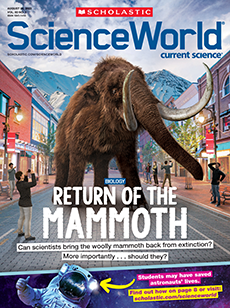Off the coast of Florida, a two-month-old bottlenose dolphin was in trouble. A rope was tangled around her tail, cutting off blood flow. Rescuers freed the baby dolphin, which they named Winter, and rushed her to nearby Clearwater Marine Aquarium. Winter recovered, but veterinarians couldn’t save her damaged tail. Without it, she couldn’t swim properly—a skill essential for her survival.
Kevin Carroll and Dan Strzempka heard Winter’s story and offered to help. They design prostheses for people with missing limbs at Hanger Clinic in Maryland. Together they created a flexible replacement tail that had a soft silicone liner. To assess whether the tail was comfortable for Winter, the team used a heat-sensing camera. It detected hot spots where the liner chafed Winter. “If we didn’t do something, that could cause breakdown of her skin,” says Strzempka. The team’s solution: They invented a material called WintersGel. They used it to make a squishy sleeve that would protect Winter’s skin while she wore her new tail.
Thanks to prostheses, injured animals like Winter are getting a second chance at life. And their stories give hope to countless people as well. Innovations like the high-tech material made for Winter are helping experts create better, more comfortable artificial limbs for people too. “There are thousands of people all over the world now wearing prosthetics lined with WintersGel,” says Carroll.
A two-month-old bottlenose dolphin was in trouble off the coast of Florida. A rope was tangled around her tail, cutting off blood flow. Rescuers freed her and rushed her to nearby Clearwater Marine Aquarium. The baby dolphin, named Winter, got better. But veterinarians couldn’t save her injured tail. Without it, she couldn’t swim properly. And that was important for her survival.
Kevin Carroll and Dan Strzempka work at Hanger Clinic in Maryland. They design prostheses for people with missing limbs. When they heard Winter’s story, they offered to help. Together they created a new tail that could bend. It had a soft silicone liner. They needed to know if the tail was comfortable for Winter. So they used a heat-sensing camera. It revealed hot spots where the liner rubbed Winter. “If we didn’t do something, that could cause breakdown of her skin,” says Strzempka. To solve the problem, the team invented a material called WintersGel. They used it to make a squishy sleeve. It protects Winter’s skin when she wears her new tail.
Winter and other injured animals are getting a second chance, thanks to prostheses. Their stories also give hope to many people. Inventions like the high-tech material made for Winter are helping people too. Experts use them to create better, more comfortable artificial limbs. “There are thousands of people all over the world now wearing prosthetics lined with WintersGel,” says Carroll.

 To ensure a perfect fit, rescuers made a mold of Mr. Stubbs’s lower body.
To ensure a perfect fit, rescuers made a mold of Mr. Stubbs’s lower body. To ensure a perfect fit, rescuers made a mold of Mr. Stubbs’s lower body.
To ensure a perfect fit, rescuers made a mold of Mr. Stubbs’s lower body. The mold would then be filled with resin to make a replica of the area where the prosthetic tail would attach to Mr. Stubbs.
The mold would then be filled with resin to make a replica of the area where the prosthetic tail would attach to Mr. Stubbs. The mold would then be filled with resin to make a replica of the area where the prosthetic tail would attach to Mr. Stubbs.
The mold would then be filled with resin to make a replica of the area where the prosthetic tail would attach to Mr. Stubbs. They covered the replica in silicone rubber and then attached the new tail.
They covered the replica in silicone rubber and then attached the new tail. They covered the replica in silicone rubber and then attached the new tail.
They covered the replica in silicone rubber and then attached the new tail. When the rubber was dry, they peeled it off the mold to make a sleeve that would fit snuggly onto Mr. Stubbs’s body.
When the rubber was dry, they peeled it off the mold to make a sleeve that would fit snuggly onto Mr. Stubbs’s body. When the rubber was dry, they peeled it off the mold to make a sleeve that would fit snuggly onto Mr. Stubbs’s body.
When the rubber was dry, they peeled it off the mold to make a sleeve that would fit snuggly onto Mr. Stubbs’s body.